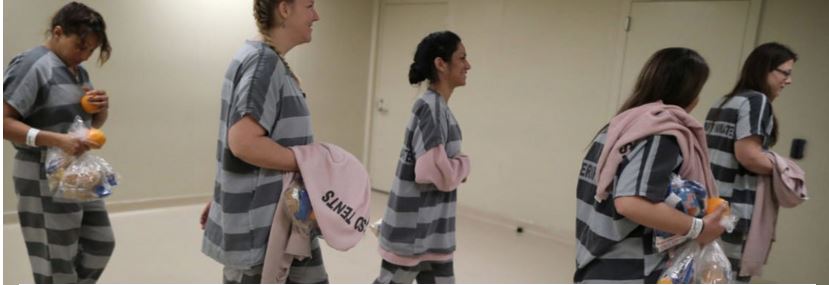Female Inmates Lack Access To Basic Needs, DOJ Inspector General Finds

- The Office of the Inspector General at the U.S. Department of Justice made public a report on the Federal Bureau of Prisons’ (BOP) management of its female population.
- One expert found the results “damning” and another found them “horrifying.”
- The report found a lack of access to basic needs for female inmates.
A majority of female inmates in prisons across the U.S. have not been provided basic needs, including feminine hygiene products and access to trauma and pregnancy programs, a Department of Justice (DOJ) investigation into the Federal Bureau of Prisons’ (BOP) management of its female inmate population revealed in a report made public Tuesday.
“Our review identified instances in which BOP’s programming and policy has not fully considered the needs of female inmates, which has made it difficult for inmates to access certain key programs and supplies,” Justice Department Inspector General Michael Horowitz’s report states.
While female inmates made up just 7 percent of the total BOP sentenced inmate population of 146,084 as of September 2016, correctional officers have noticed that females have much different, and in some cases stronger, needs.
One of the main conclusions from the report, which gathered information between 2012 and 2016, was that while about 90 percent of women are affected by physical and emotional trauma early on in their incarceration, the BOP was unable to provide its trauma treatment program to all eligible female inmates because it only staffed one program director to each institution.
“It’s really disturbing to see the findings in this report,” Amy Fettig, Deputy Director of the National Prison Project at the American Civil Liberties Union (ACLU), told The Daily Caller News Foundation.
“For example, the trauma based care, which is well recognized in the federal system and across the country as especially critical for women prisoners as so many of them have been subject to physical and emotional abuse prior to their incarceration,” she added, and “only 3 percent actually get the treatment they need.”
On top of the BOP not being able to provide trauma treatment was its inability to provide pregnant women with access to pregnancy programs and basic pregnancy care.
Only 37 percent of pregnant inmates obtained access to pregnancy programs between 2012 and 2016.
Gloria Killian is an executive director of the Action Committee For Women In Prison (ACWIP), an organization that advocates for the humane treatment of female inmates.
Killian was imprisoned for nearly two decades for a crime she says she did not commit until the 9th Circuit Court of Appeals overturned her conviction.
“I spent 17 and a half years in prison,” Killian told TheDCNF. “So I have a pretty good idea of what goes on inside.”
Horowitz said his team went on multiple visits to facilities around the country and found a lack of adequate distribution of feminine hygiene products nationwide.
“They [the institutions] didn’t have feminine hygiene products because they’d run out,” Killian told TheDCNF. “Well I don’t care if you ran out. You better go get some!”
Horowitz found the lack of sufficient and trained staff is mainly what has led to such delays in treatments and sheer lack of access to necessary programs for female inmates, but Fettig and Killian both said the main problem is that female prisons are treated as an “afterthought” and as “second class.”
The report also notes in the results that BOP was unable to adhere to policies relating to female inmates because BOP has only recently formalized such regulations. On top of this, BOP hasn’t had adequate staffing to fully complete its mission.
For example, BOP has a policy, the Prison Rape Elimination Act of 2003, which prohibits male correctional officers from searching female inmates, which means when there’s a male at that post, a female officer must leave her assigned post and current project to conduct the searches. (RELATED: Transgender Prisoners In Connecticut Can Now Get Housed Based On Gender Identity)
“Give me a break,” Killian said about the Act. “If someone is after you, they will get you. They don’t have to be assigned to a particular post.”
This is what Killian was most concerned about: the report’s failure to thoroughly mention the sexual assault that allegedly runs rampant through prisons, for both men and women.
Killian recalls male prison guards reluctantly being assigned to female institutions, saying “they just didn’t want to deal with it [feminine hygiene].”
“And then there were guys who couldn’t wait to get there, and you can just imagine why,” she said.
When told the 60-page report mentioned sexual assault only a handful of times, she replied, “Wow. That’s horrifying.”
The BOP has four security levels for inmates: high, medium, low, and minimum. Nearly all sentenced female inmates are classified as low or minimum security, the report says.
Killian and Fettig both agree this report is an important first step toward improving conditions for female inmates, but a congressional component is imperative.
“It’s [the report] a heads up for Congress who bears the oversight role of the Federal Bureau of Prisons and the Department of Justice itself,” Fettig said, while adding that because this report is now available, Congress should hold a hearing that looks specifically at the treatment of female prisoners if the BOP is not going to do enough.
The report provided the BOP with 10 broad recommendations to improve management and oversight of its female inmate population, ranging from “enhancing the capacity of BOP’s trauma treatment program, communicating information about pregnancy programs, and clarifying guidance on the distribution of feminine hygiene products.”
BOP agreed with all 10 of the recommendations.
Follow Hanna on Twitter
Email tips to [email protected]
Content created by The Daily Caller News Foundation is available without charge to any eligible news publisher that can provide a large audience. For licensing opportunities of our original content, please contact [email protected].




disturbing, yet well known. The investigation report is from 2013 - 2016 , When Heatherts findings get submitted, big changes for sure
We are all eagerly waiting for these changes and pray for all that are being mistreated - I am praying daily.